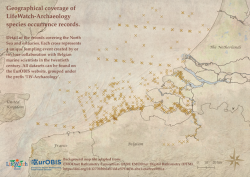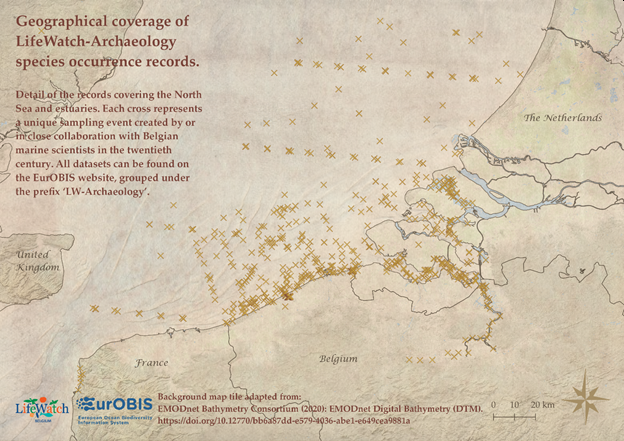LifeWatch to the (data) rescue: More than 90 historical datasets available!
Collected once, ready to be used many times!

Starting in 2012, the LifeWatch team at the Flanders Marine Institute (VLIZ) has made efforts to process and digitize over 100 historical biodiversity datasets that were created by or collected in close collaboration with Belgian marine scientists. Over the last year, 90 of these datasets were further processed to become part of the European Ocean Biodiversity Information System (EurOBIS), which is an important building block of the LifeWatch Species Information Backbone.
The digitisation and processing of these historical datasets was possible thanks to the support of the LifeWatch Species Information Backbone. LifeWatch, the E-Science European Infrastructure for Biodiversity and Ecosystem Research, is a distributed virtual laboratory, which is used for different aspects of biodiversity research. The Species Information Backbone of LifeWatch aims at bringing together biodiversity data and filling the gaps in our knowledge.
Although the data cover past observations (twentieth century), investing time in making these historical data available through online systems is of very high value, as looking at the past will help us to better understand the future. Data archaeology fills in a historical data gap and provides the necessary baseline information for inter alia species distribution and climate change models.
The 90 new datasets now made available online, mainly cover the North Sea and provide the historical context for present observations, thereby facilitating the process of setting reference conditions for monitoring and management activities in this area.
The application of the FAIR Principles in our procedures ensures the findability, accessibility, and interoperability of the (meta)data, which facilitates the reuse of the historical data and allows for easy comparing with newly obtained data. All datasets have been formatted to the internationally accepted DarwinCore format (DwC), and BODC vocabularies were mapped to measurements and facts, thus improving data interoperability. The data passed our quality control procedures and are now freely available and accessible via different channels: the Belgian LifeWatch e-Lab, EMODnet Biology project, through its Data Catalogue, Data Download Toolbox, web services and IPT, and also via the Ocean Biodiversity Information System (OBIS) and the Global Biodiversity Information Facility (GBIF), allowing the wider user community to reuse the data for their work.
These 90 datasets comprise 305,529 occurrence records of 3,758 different taxa from small meiofauna as well as bigger macrobenthos communities, with the earliest occurrence record dating back to 1903. Furthermore, the usage of the DarwinCore OBIS-ENV format allowed the inclusion of 417 disctinct measurement types and facts in a separate measurements-and-facts extension table (eMoF).
Below: geographical coverage of LifeWatch Data Archaeology species occurrence records.
All datasets can be found on the EurOBIS website, grouped under the prefix ‘LW-Archaeology’.

The digitisation and processing of these historical datasets was possible thanks to the support of the LifeWatch Species Information Backbone. LifeWatch, the E-Science European Infrastructure for Biodiversity and Ecosystem Research, is a distributed virtual laboratory, which is used for different aspects of biodiversity research. The Species Information Backbone of LifeWatch aims at bringing together biodiversity data and filling the gaps in our knowledge.
Although the data cover past observations (twentieth century), investing time in making these historical data available through online systems is of very high value, as looking at the past will help us to better understand the future. Data archaeology fills in a historical data gap and provides the necessary baseline information for inter alia species distribution and climate change models.
The 90 new datasets now made available online, mainly cover the North Sea and provide the historical context for present observations, thereby facilitating the process of setting reference conditions for monitoring and management activities in this area.
The application of the FAIR Principles in our procedures ensures the findability, accessibility, and interoperability of the (meta)data, which facilitates the reuse of the historical data and allows for easy comparing with newly obtained data. All datasets have been formatted to the internationally accepted DarwinCore format (DwC), and BODC vocabularies were mapped to measurements and facts, thus improving data interoperability. The data passed our quality control procedures and are now freely available and accessible via different channels: the Belgian LifeWatch e-Lab, EMODnet Biology project, through its Data Catalogue, Data Download Toolbox, web services and IPT, and also via the Ocean Biodiversity Information System (OBIS) and the Global Biodiversity Information Facility (GBIF), allowing the wider user community to reuse the data for their work.
These 90 datasets comprise 305,529 occurrence records of 3,758 different taxa from small meiofauna as well as bigger macrobenthos communities, with the earliest occurrence record dating back to 1903. Furthermore, the usage of the DarwinCore OBIS-ENV format allowed the inclusion of 417 disctinct measurement types and facts in a separate measurements-and-facts extension table (eMoF).
Below: geographical coverage of LifeWatch Data Archaeology species occurrence records.
All datasets can be found on the EurOBIS website, grouped under the prefix ‘LW-Archaeology’.




